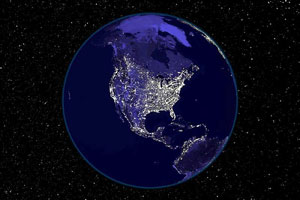Mark your calendars for March 16 through 28. Don't ask why, yet. Now, read on....
 Composite image showing centers of urban light emission
Composite image showing centers of urban light emission
Credit: NASAWant a chance to do some "citizen" science, contribute to an international investigation, and have some fun to boot? An opportunity is coming up in March: Globe At Night. All you need is your eyes....
The problem is summed up in two words: light pollution. A good deal of light produced by human civilization--streetlights, porch lights, shopping malls, security lighting, night time work lights, store fronts, parking lot lights, billboards, neon signs, the list is lengthy--shines or reflects upward into the atmosphere, there scattering off of suspended particles, like dust grains, water droplets, ice crystals and the like.
The scattered light shines back down from the sky, and we see it as a dull nocturnal glow, sometime faint, and sometimes quite pronounced. The amount of scattering particles in the air has an effect on the brightness of the night sky, but the root of the matter is the amount of light sources whose light escapes upward. The closer you are to the heart of an urban area, the more light pollution you will be subjected to.
So what? What's so harmful about that sky glow? Sometimes it can even look kind of pretty....
